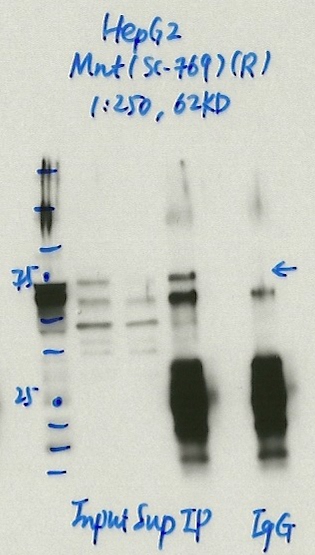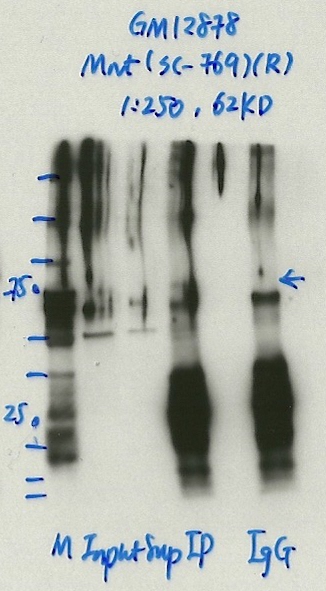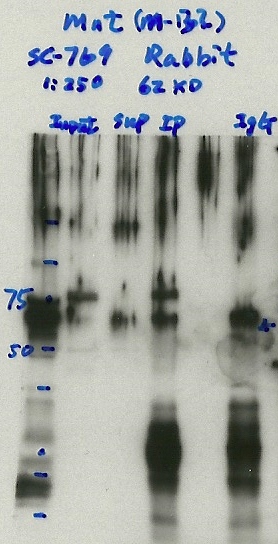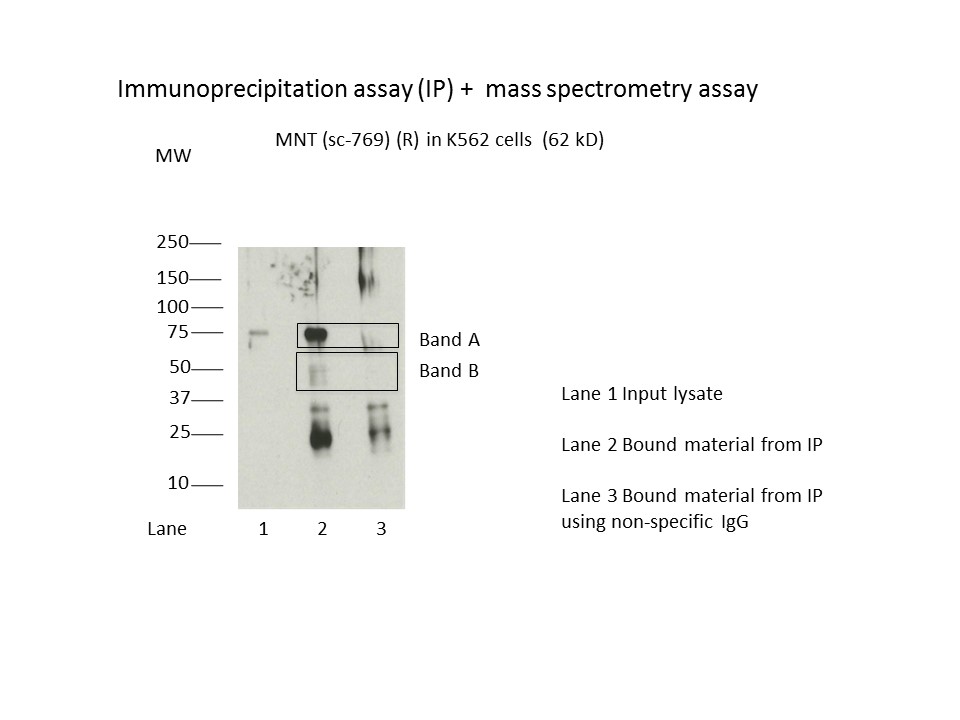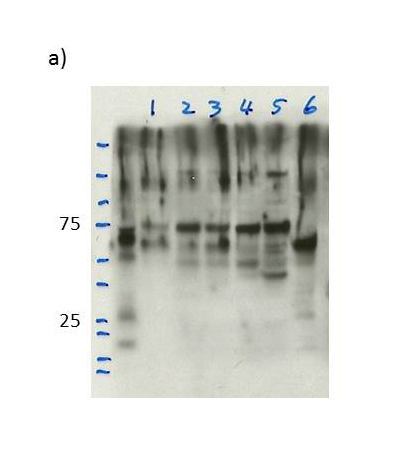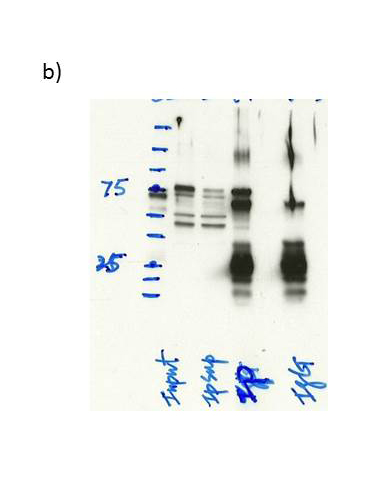ENCAB000BCL
Antibody against Homo sapiens MNT
Homo sapiens
K562, HepG2, HeLa-S3, MCF-7, liver
characterized to standards
Homo sapiens
any cell type or tissue
partially characterized
Homo sapiens
GM12878
not characterized to standards
- Status
- released
- Source (vendor)
- Santa Cruz Biotech
- Product ID
- sc-769
- Lot ID
- C1309
- Characterized targets
- MNT (Homo sapiens)
- Host
- rabbit
- Clonality
- polyclonal
- Purification
- affinity
- Isotype
- IgG
- Antigen description
- Epitope corresponding to amino acids 226-361 of Mnt of human origin
- External resources
Characterizations
MNT (Homo sapiens)
HepG2
compliant
- Caption
- Immunoprecipitation was performed on nuclear extracts from the cell line: HepG2, using the antibody sc-769. The blot shows western blot analysis of input, flowthrough, immunoprecipitate and mock immunoprecipitate using IgG.
- Submitted by
- Denis Salins
- Lab
- Michael Snyder, Stanford
- Grant
- U54HG006996
MNT (Homo sapiens)
K562
compliant
- Caption
- Immunoprecipitation of MNT from K562 cells using sc-769. Lane 1: input nuclear lysate. Lane 2: material immunoprecipitated with sc-769. Lane 3: material immunoprecipitated using control IgG. Band A was excised from gel and subject to analysis by mass spectrometry. The expected band size is 62 kDa.
- Submitted by
- Kathrina Onate
- Lab
- Michael Snyder, Stanford
- Grant
- U54HG006996
- Download
- 1006_MNT.jpg
MNT (Homo sapiens)
Method: immunoprecipitation followed by mass spectrometry
compliant
- Caption
- IP followed by mass spectrometry. Briefly, protein was immunoprecipitated from K562 nuclear cell lysates using the antibody sc-769, and the IP fraction was loaded on a 10% polyacrylamide gel (NuPAGEBis-Tris Gel) and separated with an Invitrogen NuPAGE electrophoresis system. The gel was stained by ColloidialCoomassie G-250 stain, gel fragments corresponding to the bands indicated were excised. Then proteins were trypsinized using the in-gel digestion method. Digested proteins were analyzed on an Orbitrap Elite mass spectrometer (Thermo Scientific) by the nanoLC-ESI-MS/MS technique. Peptides were identified by the SEQUEST algorithm and filtered with a high confidence threshold (Peptide false discovery rate < 1%, 2 unique peptides per protein minimum, mass error < 10 ppm).
- Submitted by
- Nathaniel Watson
- Lab
- Michael Snyder, Stanford
- Grant
- U54HG006996
- Download
- 1013 MNT_sc-769 final.pdf
MNT (Homo sapiens)
not submitted for review by lab
- Caption
- Immunoprecipitation was performed on nuclear extracts from the cell line: GM12878, using the antibody sc-769. The blot shows western blot analysis of input, flowthrough, immunoprecipitate and mock immunoprecipitate using IgG.Molecular Weight: 62.0
- Submitted by
- Denis Salins
- Lab
- Michael Snyder, Stanford
- Grant
- U54HG006996
MNT (Homo sapiens)
K562
not compliant
- Caption
- Immunoprecipitation was performed on nuclear extracts from the cell line: K562, using the antibody sc-769. The blot shows western blot analysis of input, flowthrough, immunoprecipitate and mock immunoprecipitate using IgG.
- Reviewer comment
- Band shared by IGG control lane, gel is also not clear.
- Submitted by
- Denis Salins
- Lab
- Michael Snyder, Stanford
- Grant
- U54HG006996
- Download
- Expt1033_5.jpg
MNT (Homo sapiens)
K562
compliant
- Caption
- Immunoprecipitation was performed on nuclear extracts from the cell line K562 using the antibody sc-769. Lane 1: input nuclear lysate. Lane 2: material immunoprecipitated with antibody. Lane 3: material immunoprecipitated using control IgG. Marked bands were excised from gel and subjected to analysis by mass spectrometry. Target molecular weight: 62.0.
- Submitted by
- Nathaniel Watson
- Lab
- Michael Snyder, Stanford
- Grant
- U54HG006996
- Download
- MNT.jpg
MNT (Homo sapiens)
Method: immunoprecipitation followed by mass spectrometry
not compliant
- Caption
- IP followed by mass spectrometry: Briefly, protein was immunoprecipitated from K562 nuclear cell lysates using sc-769, and the IP fraction was loaded on a 10% polyacrylamide gel (NuPAGEBis-Tris Gel) and separated with an Invitrogen NuPAGE electrophoresis system. The gel was stained by ColloidialCoomassie G-250 stain, gel fragments corresponding to the bands indicated were excised. Then proteins were trypsinized using the in-gel digestion method. Digested proteins were analyzed on an Orbitrap Elite mass spectrometer (Thermo Scientific) by the nanoLC-ESI-MS/MS technique. Peptides were identified by the SEQUEST algorithm and filtered with a high confidence threshold (Peptide false discovery rate < 1%, 2 unique peptides per protein minimum, mass error < 10 ppm).
- Reviewer comment
- Explanation needed for MCM6 and MCM4 ranked higher than MNT
- Submitted by
- Kathrina Onate
- Lab
- Michael Snyder, Stanford
- Grant
- U54HG006996
- Download
- MNT_sc-769 final (1) MNT_sc769.pdf
MNT (Homo sapiens)
GM12878K562HepG2HeLa-S3MCF-7liver
compliant
- Caption
- a) Western blot analysis of nuclear lysates prepared from multiple cells lines loaded in the order: GM12878, K562, HepG2, HelaS3,MCF7, Liver using the antibody sc-769.
- Reviewer comment
- Multiple bands, none >50% of total signal in lane. Expected size (~62kD) not indicated.
- Submitted by
- Trupti Kawli
- Lab
- Michael Snyder, Stanford
- Grant
- U54HG006996
- Download
- MNT_sc-769_WB_a.jpg
MNT (Homo sapiens)
MCF-7
not compliant
- Caption
- b) Immunoprecipitation was performed on nuclear extracts from the cell line: MCF7, using the antibody sc-769 .The blot shows western blot analysis of input, flowthrough, immunoprecipitate and mock immunoprecipitate using IgG. Expected size ~62 kDa.
- Reviewer comment
- Multiple prominent bands - may possibly be rescued with a knockdown characterization against the factor.
- Submitted by
- Trupti Kawli
- Lab
- Michael Snyder, Stanford
- Grant
- U54HG006996
- Download
- MNT_sc-769_WB_b.jpg
